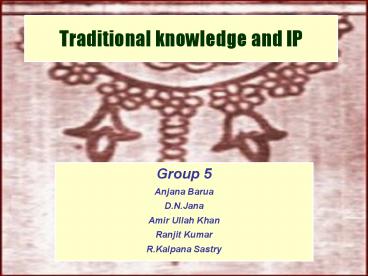Traditional knowledge and IP PowerPoint PPT Presentation
1 / 16
Title: Traditional knowledge and IP
1
Traditional knowledge and IP
- Group 5
- Anjana Barua
- D.N.Jana
- Amir Ullah Khan
- Ranjit Kumar
- R.Kalpana Sastry
2
Indigenous knowledge
- History shows that skills and knowledge base of
societies encompasses all fields - Patronage of art/culture in ancient times
- India with a rich heritage
- Has been a repository of knowledge wealth
- Now how do we preserve and gain competitive
advantage?
3
Preserve and gain competitive advantage
- Issues in protection
- Individual Vs Community rights
- Time bound monopolies
- Prime goal of IPR public domain
- Historical wrongs
- The tribe that dances never dies
4
The players in the game
- Concerned individuals
- Traditional societies
- Fashion designers, entertainers, drug firms, bio
tech companies - Sociologists, Anthropologists, Historians
- Future generations
5
What do we have
- we have, on the one hand, traditional innovation
systems with a definite set of values and, more
importantly, societal roles promoting that
innovation - we have a bureaucracy that makes a rule and a
form out of everything - we have corporate interests
6
Case Study-
- Kalamkari-
- the technique of painting cloth with a pointed
bamboo kalam or pen, - Kalamkari is almost an industry in Andhra
Pradesh., - However, most of the Kalamkari work one sees
today is a mix of printed and pen work - and is generally aimed at the home furnishing
market.
7
Art since 16th century
- Ethnic, colorful and eye catching Kalamkaris play
an important part in folk life and rituals. - This art, which has its origin in Andhra
Pradesh, has been passed on from father to son
down the generations. - Kalamkari works represent Hindu mythology and
its symbolism or Mughal scenes. - Appreciated in Europe since 16th century, these
are used as wall hangings
8
Srikalahasti school
- Kalamkaris are used in clothes, cushion covers,
bedspreads, etc. - Hand painted cloths of Sri Kalahasti, Andhra
Pradesh, works of art drawn entirely by hand,
were originally created predominantly for the
temples as narrative murals.These murals tell the
stories of the great Hindu epics in picture form
9
Masulipatnam school
- Masulipatnam designs are Iranian in character
with intricate and delicate forms. The old
traditional block prints were largely used with
Persian motifs like trees, creepers, flowers and
leaf designs. Later came the Dutch influence when
there was an increase in demand from Europe. This
style of Kalamkari was mainly done on bed covers,
curtains and also garments, as it was a popular
demand from the west. In the nineteenth century,
block prints reached its peak and even today it
is largely produced for Indians and foreigners
10
Masalipatnam school
- The Masalipatnam kalamkari uses wood blocks to
print designs. However the use of vegetable dyes
and mordants make it still a time consuming
process .
11
Process
- The process involves treating of cotton fabric
with buffalo dung. Then myrobalan,a tanin
containing pod is pounded and soaked to produce a
liquid This is combined with milk and used to
soak the fabric. - The myrobalan acts as a mordant binding the dye
to the cloth and the milk keeps the drawn line
from running. The initial drawing is done with a
rust iron solution, created by soaking rusty
metal with molassas, water, and bran for 14 days.
- After drying for one day, the cloth is boiled
with madder, vegetable dye. The red only
penetrated the areas treated with alum. Many more
processes are used for the remaining colours.
12
IPR portfolio?
- GI?
- Designs
- Process patent?
- Product patent on wide use of dyes as herbals and
other value additions - Protection of motifs
- Trademarks
13
People speak
- The knowledge people possess regarding vegetable
dyes was the individual property of the artisan
group. We should give them back that knowledge."
says L. Kannan of PPST. - The wheel has turned full circle and people are
going back to vegetable dyes. Since there is a
danger of industrial houses overshadowing the
artisan leading to his marginalisation, one's
work should be oriented towards bringing him back
into the picture. "We need to tread cautiously,
for attempts to encourage the craft could be
counter-productive. Several corporate companies
are trying to make powder extracts to make the
process easy. It will have an adverse impact on
our ecology if certain dyes are produced in bulk
as roots, barks and flowers have various uses in
medicine and other fields." - Kanan, Local artisan from Srikalahasti,The Hindu
Frontier magazine,June1999
14
Solution from artisans
- The ideal solution is for promotion to be linked
in a sustainable way with the community of
artisans and ecology. Smaller scales of
production using a wide variety of natural
resources would be the answer, says Kannan.
15
What do we do?
- Building awareness
- Databases for archival value for
libraries/research - Teaching cultural knowledge in universities
- Using virtual net
- Lease enabling organizations to overcome over
exploitations
16
Sustainable answers
- Conservation techniques for resources
- Policy for collection-BDA etc.,.
- Train locals in sustainable use
- Value addition
- IPR policy
- Benefit sharing-community,cooperatives,state
- Respecting the ethical considerations
- Quality consciousness,rel. sentiments,generation
art - Self Practicing ethics and value in true sense

